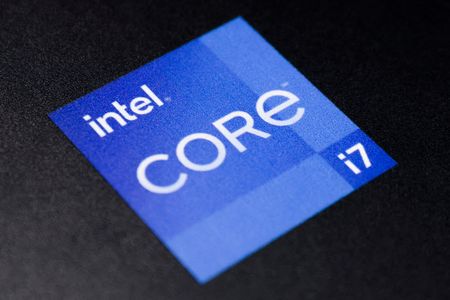
By David Shepardson and Jane Lanhee Lee
WASHINGTON/SAN FRANCISCO (Reuters) -Intel Corp said on Friday it would invest up to $100 billion to build potentially the world’s largest chip-making complex in Ohio, looking to boost capacity as a global shortage of semiconductors affects everything from smartphones to cars.
The move is part of Chief Executive Officer Pat Gelsinger’s strategy to restore Intel’s dominance in chip making and reduce America’s reliance on Asian manufacturing hubs, which have a tight hold on the market.
An initial $20 billion investment – the largest in Ohio’s history – on a 1,000-acre site in New Albany will create 3,000 jobs, Gelsinger said. That could grow to $100 billion with eight total fabrication plants and would be the largest investment on record in Ohio, he told Reuters.
Dubbed the silicon heartland, it could become “the largest semiconductor manufacturing location on the planet,” he said.
While chipmakers are scrambling to boost output, Intel’s plans for new factories will not alleviate the current supply crunch, because such complexes take years to build.
Gelsinger reiterated on Friday he expected the chip shortages to persist into 2023.
To dramatically increase chip production in the United States, the Biden administration aims to persuade Congress to approve $52 billion in subsidy funding.
U.S. House Speaker Nancy Pelosi said on Friday the House of Representatives would soon introduce a bill on competitiveness to help bolster semiconductor investment and supply chains. That would include the $52 billion funding https://www.reuters.com/world/us/pelosi-says-us-house-will-soon-introduce-competitiveness-bill-2022-01-21.
U.S. President Joe Biden touted Intel’s investment on Friday at a White House event with Gelsinger and again made the case for congressional action.
“China is doing everything it can to take over the global market so they can try to out compete the rest of us,” Biden said.
U.S. Commerce Secretary Gina Raimondo said at the event the current semiconductor supply chain is “far too dependent on conditions and countries halfway around the world.”
Gelsinger said without government funding “we’re still going to start the Ohio site. It’s just not going to happen as fast and it’s not going to grow as big as quickly.”
THE CHIP FEAST AND FAMINE
Intel ceded the No. 1 semiconductor vendor spot to Samsung Electronics Co Ltd in 2021, dropping to second with growth of just 0.5%, the lowest rate in the top 25, data from Gartner showed.
As part of its turnaround plan to become a major manufacturer of chips for outside customers, Intel broke ground on two factories in Arizona in September. The $20 billion plants will bring the total number of Intel factories at its campus in the Phoenix suburb of Chandler to six.
Gelsinger told Reuters he still hoped to announce another major manufacturing site in Europe in coming months.
It is not just Intel ramping up investments. Rivals Samsung Electronics and Taiwan Semiconductor Manufacturing Co or TSMC also have announced big investment plans in the U.S. And that’s raising questions about a glut in chips going forward.
“We still have years in front of us before we’re even having a semblance of supply demand balance,” said Gelsinger. “Ask yourself what portion of your life is not becoming more digital.”
“Yes, the industry is growing, and maybe the metaverse solves world hunger for the semiconductor industry. But there is a big bubble coming,” said Alan Priestley, an analyst at Gartner.
U.S.-CHINA TECH WAR
The U.S. build up comes as a tech war between the U.S. and China is causing a decoupling of certain technologies, such as chips. Companies looking to sell technologies to China are considering basing outside of the U.S. to avoid being snagged by U.S. export control rules. China is also investing heavily in its semiconductor manufacturing capacity.
While Gelsinger also touted the security and economic benefits of boosting U.S. chip production on Friday, Bloomberg reported in November that the Biden administration pushed back against a prior plan by the company to boost silicon wafer production in China over national security concerns.
Intel has drawn fire for its decision to delete references to Xinjiang from an annual letter to suppliers after the chipmaker faced a backlash in China for asking suppliers to avoid the sanctions-hit region.
When asked about it in a briefing last month, White House press secretary Jen Psaki said she could not comment on the company specifically, but said “American companies should never feel the need to apologize for standing up for fundamental human rights or opposing repression,” reiterating a call to industry to ensure that they are not sourcing products that involve forced labor from Xinjiang and urging companies to oppose China’s “weaponizing of its markets to stifle support for human rights.”
Intel’s Ohio investment is expected to attract partners and suppliers. Air Products, Applied Materials, LAM Research and Ultra Clean Technology have shown interest in establishing a presence in the region, Intel said.
Construction of the first two factories is expected to begin late in 2022 and production in 2025.
(Reporting by David Shepardson and Alex Alper in Washington, Jane Lee in San Francisco, Jeff Mason in Washington D.C., Nivedita Balu, Sweta Singh and Akriti Sharma in Bengaluru; Editing by Christopher Cushing, Anil D’Silva, John Stonestreet and Bernard Orr)

